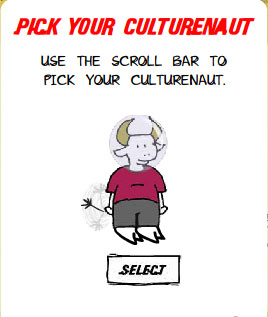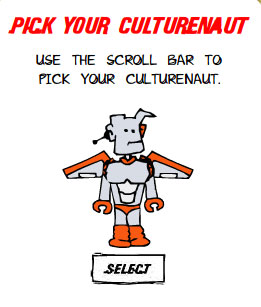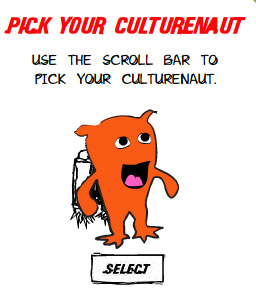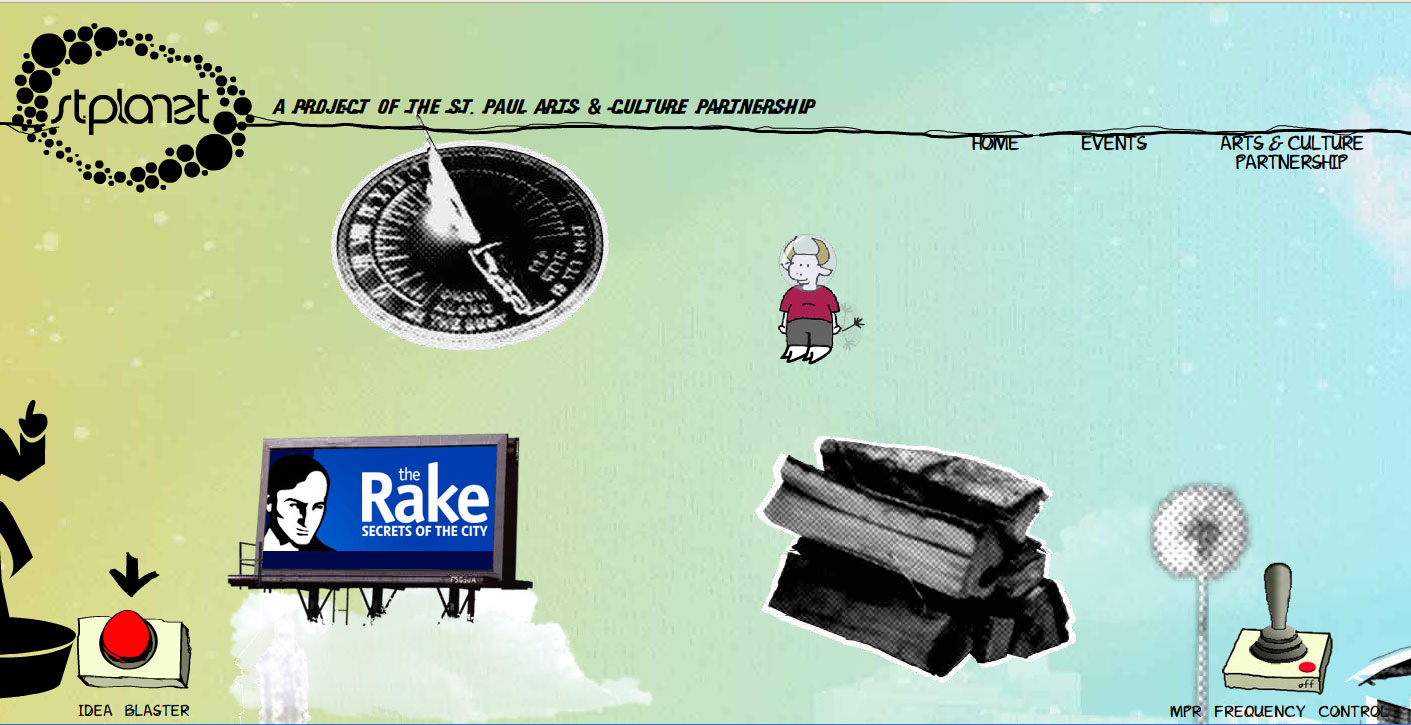Culturenauts Land on the Planet of St. Paul
Jay Gabler investigates the story behind the creation of a new website, "St. Planet," which aims to capture a hip young online audience for cultural organizations in St. Paul. Check it out and decide for yourself whether or not they're on the right track.





You are a “culturenaut.” In the form of a winged robot, or a space-helmeted bovine, or a bulbous humanoid with a rocket pack, you drift placidly above Minnesota’s capital city. As a culturenaut, you perceive the natural landscape only dimly; centers of industry and commerce appear as vague shadows. Cultural institutions, however (including Landmark Center, the Minnesota Museum of American Art, and the Children’s Museum) loom large, flashing with colors and spawning informational text balloons as you fly past. When you ascend into mustard-tinted clouds, you encounter a number of strange images, among them a flying sundial (The History Theatre), an oversized dandelion (New Breath Productions), and a stack of firewood (Minnesota Woodturners Association).
This hallucinatory experience, previously accessible only by sitting in Rice Park alternating puffs on a Winston Light with sniffs on a Magic Marker, is now available to anyone with an internet connection thanks to the efforts of the Arts and Culture Partnership of St. Paul (ACP). The twelve-year-old ACP, a non-profit organization dedicated to promoting the capital’s cultural scene, recently unveiled its new web site (stpaulculture.com), which carries the moniker “St. Planet.”
The site was designed with the aim of orienting young adults to the cultural institutions east of the Mississippi. “We want people to think ‘arts and culture’ when they think ‘St. Paul,’” says ACP marketing chair Sarah Fossen. “We don’t want people thinking the Science Museum is in Minneapolis, or going to the Ordway and thinking they’re in Bloomington.”
When ACP decided to revamp their web site, Fossen approached Periscope, a Minneapolis advertising firm that Fossen describes as “very forward-thinking.” Periscope accepted the commission, with a mandate from Fossen and ACP to “think big, think award-winning.”
Tom Flint, head of the Periscope team that designed the site, described the project as “a great opportunity for us. We had a completely open table, with no specific mandatories from the client. Our team took that and ran with it, and we ended up with what we feel is a pretty unique approach.” Working with what Flint describes as “a very limited budget,” Periscope donated time and resources that would normally cost a client, in Flint’s estimation, “well into the tens of thousands of dollars.”
ACP is a membership organization, and a large portion of its operating budget—which has averaged approximately $55,000 annually for the past few years, according to Fossen—comes in the form of annual fees paid by its members on a sliding scale. Member organizations contribute fees ranging from $50 (for organizations with annual operating budgets under $100,000) to $3,750 (for organizations with annual budgets in excess of $10 million). ACP has also received grants from donors including the Travelers Companies and Bruce Larson.
Through its Cultural STAR (Sales Tax Revitalization) program, the City of St. Paul contributed $15,000 to the development and marketing of the St. Planet site. Joe Spencer, the mayor’s Policy Associate for Arts and Culture, praised ACP’s site as “by far the most successful” among many recent attempts by various organizations to centralize St. Paul event listings. Spencer says he is “tremendously impressed” by ACP’s partnership with The Rake magazine, which powers the site’s event listings (accessible by flying one’s animated culturenaut down to an “idea blaster” button). The Rake receives payment for its work on the event listings, but The Rake has also contributed resources beyond those for which it is being compensated.
The new site went public in October of 2007, with a launch party that Fossen describes as a great success. “We had a huge showing—over five hundred—and it was a very young, hip demographic. They weren’t the usual suspects.” The feedback from ACP members has been enthusiastic, says Fossen. “Previously, we had a very generic web site. Our members are amazed at the level of professionalism and the level of detail on the new site. It blows the doors off of video games. This is really edgy, hip, and young.”
It remains to be seen whether the site will be effective at stimulating interest in the St. Paul cultural scene. While the site, according to Fossen, is already succeeding at impressing funders and potential ACP members, the site’s fanciful free-form design may put off visitors looking for detailed and accessible information on events and venues. The offerings represented on the site are extremely varied—ranging from the Visual Arts Critics Union to the Children’s Museum to the Centennial Showboat. While the site succeeds in portraying the diversity of St. Paul’s cultural institutions, will it attract repeat visitors and bring them through organizations’ doors?
Representatives of Minnesota Public Radio, the History Theater, and the Minnesota Children’s Museum were unable to say whether the site had significantly impacted their activities. However, Brandie Grieg, managing director at the O’Shaughnessy, says that the St. Planet site has been “a good marketing tool for us. We’ve had numerous calls from people purchasing tickets after seeing us on the [ACP] Web site.”
With respect to visitor traffic on the site, says Flint, the focus is on the future. “We did have a spike, obviously, when we launched the site. It’s dropped off a little bit since then, kind of leveled off. Obviously the budgets are very limited with a non-profit, so the opportunity to go out and buy media to drive traffic to [the site] is not going to be real prevalent, but we’ve got a lot of good partners who are hopefully going to be using banner ads on their sites, so I would expect to see a gradual climb back up with the traffic. The site will be up there for at least three years, so I think there’s an opportunity for us to, over time, build a good base of regular traffic.”
“We’re just so glad we got this thing launched,” says Fossen. “Now that we know we can reach that younger demographic, the question is, how can we stay on top of this and market to them? That 21-to-35-year-old group is such a big group, and it’s really hard to get to. They’re such an expensive market—they’re demanding. They want things to be edgy and fun and different. We’re starting to draw that audience to St. Paul.”
About the writer: Jay Gabler is assistant editor of the Twin Cities Daily Planet. He contributes to publications including The Rake, Rain Taxi Review of Books, and ARP!
A Brief Index of Local Arts Online
The ACP site is one among several Web sites featuring Minnesota arts listings. Among other notable sites:
(Of course) mnartists.org
This site, funded by the McKnight Foundation and hosted by the Walker Arts Center, allows Minnesota artists to create online galleries of their work and list their own events on a self-posting, member driven statewide arts calendar.
mplsart.com
Minneapolis visual art listings, organized by date.
Northeast Minneapolis Art Association
Openings and exhibitions in gallery-packed northeast Minneapolis.
Twin Cities Fine Arts Organization
An annotated list of museums and art galleries in the Twin Cities.
Several print and online publications include arts listings on their Web sites. Among the sites with the most extensive listings: